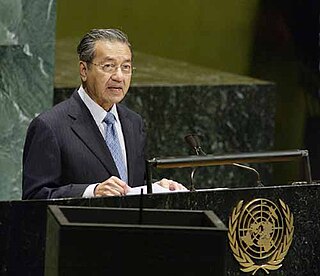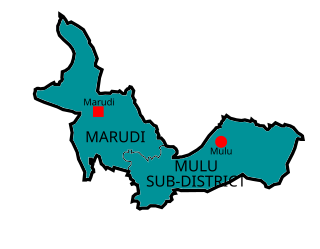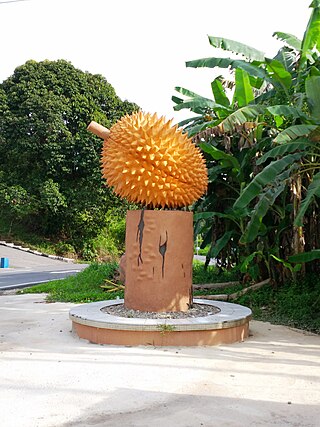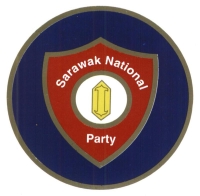
The Ibans or Sea Dayaks are a branch of the Dayak peoples on the island of Borneo in South East Asia. Dayak is a title given by the British to the local tribe people of Borneo island. It is believed that the term "Iban" was originally an exonym used by the Kayans, who – when they initially came into contact with them – referred to the Sea Dayaks in the upper Rajang river region as the "Hivan".

The Royal Ranger Regiment is an infantry regiment of the Malaysian Army. Although it is second in seniority to the Royal Malay Regiment, the RRD can trace its origins back to the mid 19th century and the establishment of The Sarawak Rangers, the peacekeeping force in the Sarawak region. This force was absorbed by the Sarawak Constabulary in 1932, but the name was revived in 1941 as a British Colonial unit; this unit commanded by British Lieutenant Colonel C.M. Lane was captured by the Japanese in 1942.

Parti Pesaka Bumiputera Bersatu is a right-wing political party in Malaysia. It is currently the largest political party in Sarawak. Parti Pesaka Bumiputera Bersatu was formed from the combination of three parties in Sarawak; Parti Negara Sarawak, Barisan Rakyat Jati Sarawak and Parti Pesaka Anak Sarawak. The formation of the party was for the purpose of the improvement of the livelihood and protect the rights of the Bumiputera in many fields such as politics, economy and social. Formerly a part of Semenanjung-based coalition Barisan Nasional (BN), following the defeat of BN in the 2018 general election and in the aftermath of a meeting between all Sarawak-based BN coalition parties on 12 June 2018, PBB left the coalition to form a new Sarawak-based coalition, Sarawak Parties Alliance.

Kapit is a town and the capital of Kapit District in Kapit Division, Sarawak, Malaysia on the south bank of the Rajang River. The district comprises 15,595.6 square kilometres and as of 2020, it has a population of 65,800.

Song is a town, and the capital of the Song District in Kapit Division, Sarawak, Malaysia. The district population was 20,046 according to the 2010 census. Song is situated by the banks of the Katibas River, a tributary of the Rajang River. It is an important stopover for river traffic going up the Rajang River.

Sarikei Division is one of the twelve administrative divisions in Sarawak, Malaysia. Formerly part of the Third Division, which included Sibu and Kapit, Sarikei Division has a total area of 4,332.4 square kilometres (1,672.7 sq mi), and is the second smallest of the administrative divisions of Sarawak.

This article lists important figures and events in Malaysian public affairs during the year 1981, together with births and deaths of notable Malaysians.

WO1 Temenggong Datuk Kanang anak Langkau, SP, PGB, PGBK, PBS (Rt) was a Malaysian hero and soldier from the Iban Dayak community in Sarawak. He was in the Royal Ranger Regiment and Regimental Sergeant Major of 8 Renjer of the Malaysian Army with his tag number 901378. He was awarded the Panglima Gagah Berani and Seri Pahlawan Gagah Perkasa medals from the Yang di-Pertuan Agong, Sultan Ahmad Shah on 3 June 1981. He is the sole recipient of both the Seri Pahlawan Gagah Perkasa and Pingat Gagah Berani, and was the last living recipient of the Seri Pahlawan Gagah Perkasa.
Rentap, also known as Libau Rentap, was a warrior and a recognized Iban hero in Sarawak during the reign of the first White Rajah, James Brooke. His praisename, Rentap Tanah, Runtuh Menua translates from the Iban language as 'Earth-tremor, World-shaker'. His famous and frequently quoted slogan was "Agi idup, Agi ngelaban" which translates into "Still alive, still fighting".

Marudi is a town in the Malaysian state of Sarawak, and is a part of the division of Miri. It is the seat of Marudi District, and is located on the banks of Baram River, about 100 kilometres (62 mi) upstream from the river mouth. Marudi was the administrative centre of the northern region of Sarawak before Miri was established. Marudi is considered as the cultural heart of the Orang Ulu, the highland tribes of Sarawak. It is also a transit gateway to Gunung Mulu National Park, a UNESCO World Heritage Site.

Pakan is a small town in Pakan District, Sarikei Division, Sarawak, Malaysia. The district population estimates was 17,600.

Sylvia Leonora, Lady Brooke, Ranee of Sarawak, was an English aristocrat who became the consort to Sir Charles Vyner de Windt Brooke, Rajah of Sarawak, the last of the White Rajahs.
The oral history of the Iban has traditionally been committed to memory in the oral forms of literature i.e. inchantations and genealogies (tusut), and some of these are recorded in a system of writing on boards as pneumonics by the initiated shamans, or lemambang. This includes elaborate genealogical records, which usually go back about fifteen generations, although some purport to go back up to twenty-five. These genealogies (tusuts) are essentially records of who married who and whom begat whom. Names of individuals with great achievements in life are accompanied by a short description, a praise-name (ensumbar) and the respective narratives of their accomplishments. So, this is how the Iban records their history in the oral form.

The Sarawak National Party known by its acronym as "SNAP", is now a defunct political party in Malaysia. It was a member party of the Alliance Party from 1963 to 1966 and a member of Barisan Nasional (BN) coalition from 1976 until its expulsion in 2004. It contested the General Election in 2004 as well as the Sarawak state elections of 2006 and 2011 as an opposition party.
Tun Datuk Patinggi Temenggong Jugah anak Barieng, also known as Tun Jugah, was a Malaysian politician of Iban descent from the state of Sarawak. He was the Paramount Chief of the Iban people for more than 55 years. They affectionately called him "Apai" meaning "father" in the Iban language.
The Darjah Utama Yang Amat Mulia Bintang Sarawak is the highest state order in the state of Sarawak. It is conferred to those who rendered excellent service towards the development of the state of Sarawak and Malaysia. The Order was established in 1964, a year after Sarawak's independence with the formation of Malaysia. The history of the order can be traced back to 1928, where a similar order named Order of the Star of Sarawak was established by the White Rajahs. However, the revived order has no connection with the previous order, except for the similarity of the name of the order. The motto of the Order is based on the state motto and the current one was adopted in 1988. The design of the order ribbon was changed twice, first in 1973 and again in 1988. The design follows the colors of the Sarawakian flag: blue, red and white, and yellow, black and red. Both the Officer of the Star of Sarawak (JBS) and Officer of the Star of Hornbill Sarawak (JBS) share the same necklace design.
Sarawak exhibits notable diversity in ethnicity, culture, and language. The Sarawakian culture has been influenced by Bruneian Malays of the coastal areas. Substantial cultural influences also came from the Chinese and British cultures.












